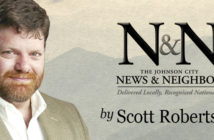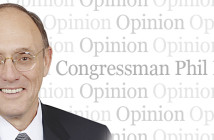By Jeff Keeling
I’ll call the following words grist for the proverbial mill, something for city commissioners and other leaders to chew on as citizens wait expectantly to see whether an iconic Johnson City landmark can be saved and effectively repurposed.
In many respects, it seems like just yesterday that East Tennessee State University President Dr. Brian Noland first floated the notion that Johnson City could partner with ETSU in construction of its Fine and Performing Arts Center.
Still recovering from a car accident that had fractured his neck, Noland stood before city commissioners in early 2014 and touted the economic and cultural advantages of a larger main hall than the 750 seats the state of Tennessee would fund. Using city dollars to help increase that main hall’s capacity to 1,200 or so could result in a venue with the ability to attract larger-scale, more prominent acts, Noland said. And in exchange for public investment, a contract could be developed allowing the city to periodically use the space.
A fine, large new venue would bring visitors to town for events, where they would spend money. It would also make Johnson City a more desirable home for talented people of the sort local companies are trying to attract as they grow, as well as self-employed entrepreneurs.
The FPAC project moved along at the state level and property was secured in Millennium Park across from ETSU’s mini-dome. Noland and ETSU Chief of Staff for External Operations Jeremy Ross continued meeting periodically with commissioners, attempting to quantify the city’s return on investment and hammer out details of any potential agreement.
Several months ago, commissioners – not unanimously and not without some reservations – approved spending up to $8 million, plus interest, to bring the FPAC’s seating capacity to 1,300. That’s a whole lot of money, and as commissioners have wrestled with this topic over two-plus years, a funny thing, you might say, has happened on the way to the theater.
When Noland first spoke to commissioners about the FPAC, the then 105-year-old Model Mill, long empty and purchased by the Chamber of Commerce Foundation in 2008, was under contract for an apartment project. Perhaps you remember the high drama that surrounded that much-maligned project, its subsequent collapse, and last year’s proposal by entrepreneur and downtown developer Joe Baker to purchase and restore the mill.
Interestingly, ETSU arts programs were part of Baker’s initial vision for a restored mill, with a suggestion that the university’s world-renowned bluegrass program could become a tenant.
The Chamber entered exclusive negotiations with Baker last summer. Those continue today as far as I can tell, but all the parties know that restoring a hulking, industrial, century-old relic into a vibrant, usable space is a very, very expensive proposition.
When last we reported on this issue in our Jan. 6 edition, Chamber CEO Gary Mabrey said, “if the numbers work, it gets pretty simple,” referring to a sale to Baker. For his part, Yee-Haw Brewing founder Baker, who has renovated two former railroad depots a stone’s throw east of the mill, has always said the numbers would have to work. In the Jan. 6 article, Mabrey said if it were determined tax increment financing (TIF) or some other public sector aid could help make the numbers work, “we will work with (Baker and Co.) to get the greatest amount of incentive possible.”
While backtracking is never easy to do, here is what I believe it would benefit everyone involved (the city, the chamber, ETSU, Baker) to consider: What are the potential benefits of a larger performing arts theater, at a public cost of $8 million, and what are the potential benefits of a historically restored mill, and all the commerce and activity that would accompany it, at a public cost of some as-yet-undetermined amount?
More importantly, what are the potential consequences to our city’s future of an ETSU FPAC with only 750 seats instead of 1,200 or 1,300 (we’ll still have an FPAC)? What are the potential consequences to our city’s future of a demolished Model Mill with some modern structures (someday, probably) in its place?
While we shouldn’t make a habit of subsidizing private development, I happen to believe the mill’s successful historic renovation would prove a watershed moment in the city’s history. Downtown and the ETSU to downtown corridor have seen significant growth and revitalization. The mill sits at the corridor’s midpoint. It was built by George L. Carter, the guy who helped make ETSU a reality.
Mabrey himself said this as 2016 dawned: “It’ll be kind of neat in a few years sitting in the mill, listening to the din, the coming and going of all those individuals and bright pieces of the puzzle and knowing, ‘you know what – we did it.’”
It’s possible, of course, that the mill deal with Baker will be feasible without public subsidy. If it isn’t, I can’t imagine it would require a full $8 million to become feasible.
Something tells me time is running short for making such a determination, though. It seems to me a reasonable thing for the parties with vested interests in the outcome to try and get together and consider the possibility I’ve outlined here.
Right now, ETSU leaders are working to eliminate some features in the initial FPAC design due to costs. Locating some arts functions in a restored mill could potentially make that process easier.
ETSU also is trying to get its non-university FPAC fundraising requirement of around $10 million over the top.
Maybe funds could be split between the two projects in such a way as to produce maximum benefit for all involved.
Chew on it, folks.




